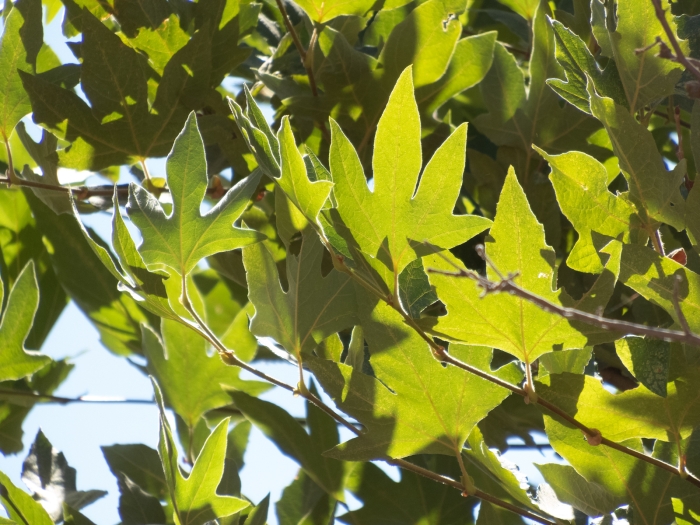California Sycamore
(Platanus racemosa)
California Sycamore (Platanus racemosa)
/
/

Kyle Nessen
Public Domain
Image By:
Kyle Nessen
Recorded By:
Copyright:
Public Domain
Copyright Notice:
Photo by: Kyle Nessen | License Type: Public Domain | License URL: http://creativecommons.org/publicdomain/zero/1.0/ | Rights Holder: Kyle Nessen | Publisher: iNaturalist | Date Created: 2018-09-14T11:12:39-07:00 |




































































































Estimated Native Range
Summary
Platanus racemosa, commonly known as California Sycamore, is a deciduous tree native to California and northwestern Mexico, specifically found in riparian zones, floodplains, and wetlands, as well as in chaparral and coastal scrub areas. It can grow to a height of 110 feet (35 meters) with a trunk diameter up to 3 feet (1 meter). The tree’s trunk often divides into multiple large trunks with an extensive branch system. The bark is a distinctive mottled pattern of white, tawny beige, pinkish gray, and pale brown, which peels away on older trees to reveal new layers. The leaves are bright green when young and woolly, turning golden to orangish-red before dropping in the fall. The inflorescences consist of spherical flower heads about a centimeter wide. California Sycamore is valued for its ability to provide dense shade in the summer while allowing sunlight to penetrate in the winter, making it a choice for green architecture and sustainable design.
The California Sycamore is appreciated for its aesthetic bark, grand stature, and seasonal color change. It is used in urban and residential landscapes, and its deep roots make it suitable for planting near pavements without causing damage. This tree requires moderate water initially but becomes drought-tolerant once established. It thrives in full sun and adapts to a variety of soil types with fast to medium drainage. However, it can be susceptible to anthracnose and powdery mildew, and its large size may not be suitable for small gardens.CC BY-SA 4.0
The California Sycamore is appreciated for its aesthetic bark, grand stature, and seasonal color change. It is used in urban and residential landscapes, and its deep roots make it suitable for planting near pavements without causing damage. This tree requires moderate water initially but becomes drought-tolerant once established. It thrives in full sun and adapts to a variety of soil types with fast to medium drainage. However, it can be susceptible to anthracnose and powdery mildew, and its large size may not be suitable for small gardens.CC BY-SA 4.0
Plant Description
- Plant Type: Tree
- Height: 30-80 feet
- Width: 20-50 feet
- Growth Rate: Slow
- Flower Color: N/A
- Flowering Season: Spring
- Leaf Retention: Deciduous
Growth Requirements
- Sun: Full Sun
- Water: Medium
- Drainage: Fast, Medium
Common Uses
Bee Garden, Bird Garden, Butterfly Garden, Deer Resistant, Drought Tolerant, Erosion Control, Fire Resistant, Hummingbird Garden, Rabbit Resistant, Street Planting
Natural Habitat
Native to riparian zones, floodplains, and wetlands, as well as chaparral and coastal scrub areas in California and northwestern Mexico
Other Names
Common Names: Western Sycamore , California Plane Tree , Aliso
Scientific Names: Platanus racemosa , Platanus californica
GBIF Accepted Name: Platanus racemosa Nutt. ex Audubon